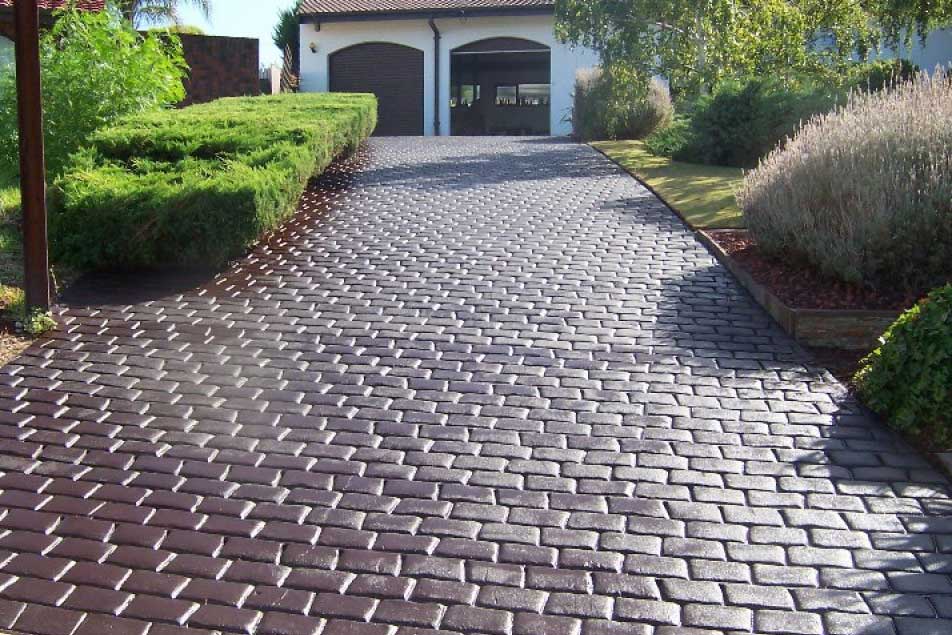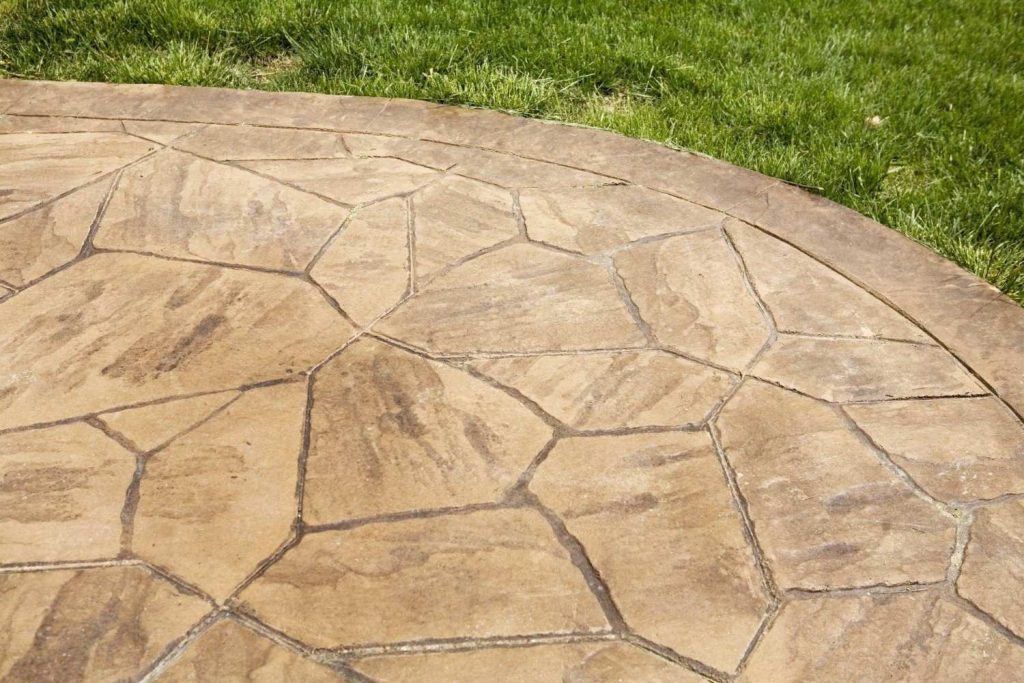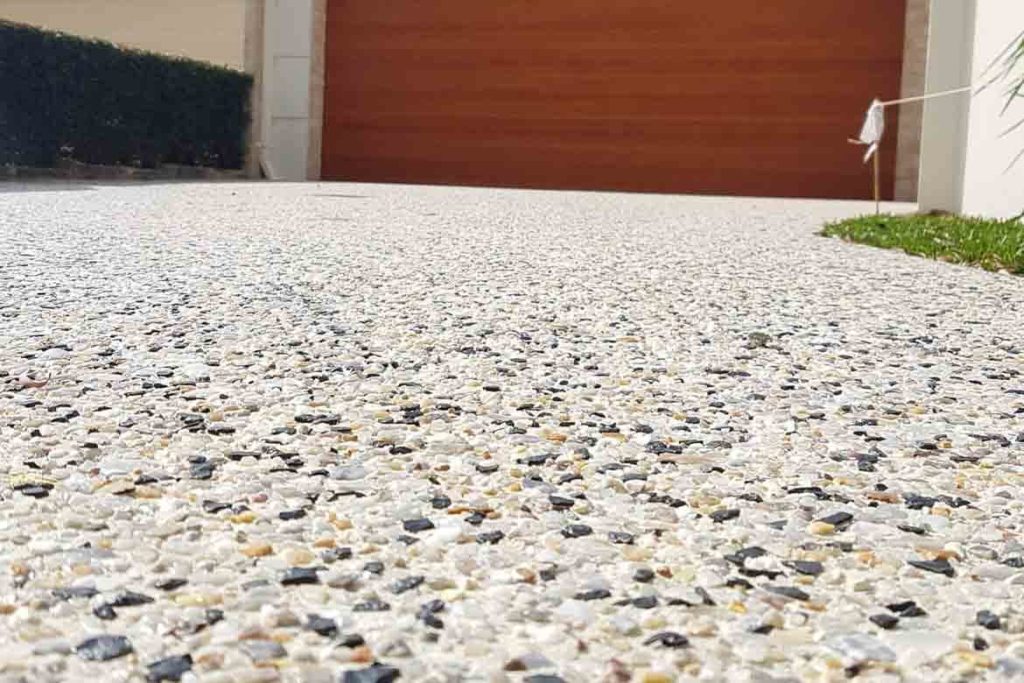
When it comes to choosing the right type of concrete for your project, understanding the differences between exposed concrete and stamped concrete is crucial.
With extensive experience in residential and commercial works, including concrete slabs, patios, driveways, and paths, I can guide you through the benefits and considerations of each type.
Table of Contents
- Exposed Concrete: Detailed Overview
- Stamped Concrete: Detailed Overview
- Comparing Costs
- Maintenance and Durability
- Design and Aesthetic Options
- Practical Applications

Choosing between exposed concrete and stamped concrete can significantly impact the look and functionality of your space. Stamped concretes, known for their versatile design options, and exposed concretes, valued for their durability, both offer unique benefits that cater to different needs.
Exposed Concrete: Detailed Overview
1. What is Exposed Concrete?
Exposed concrete involves removing the top layer of concrete paste to reveal the underlying aggregate. This process creates a rugged, non-slip surface ideal for various outdoor applications.
2. Benefits of Exposed Concrete
- Durability: Exposed concrete is highly durable, making it suitable for high traffic areas. It withstands harsh weather conditions and heavy loads, ensuring longevity.
- Low Maintenance: Once installed, exposed concrete requires minimal upkeep. Regular cleaning and occasional resealing keep it in prime condition.
- Cost-Effective: Due to its longevity and low maintenance needs, exposed concrete proves to be a cost-effective choice over time.
- Aesthetic Versatility: Available in various colours and textures, exposed concrete can be customised to match any design preference.
3. Ideal Applications
- Driveways: The robust surface can handle the weight of vehicles without cracking.
- Patios: Non-slip texture makes it perfect for outdoor seating areas.
- Pathways: Durable and visually appealing for garden paths and walkways.
Stamped Concrete: Detailed Overview
1. What is Stamped Concrete?
It involves imprinting patterns and textures onto the wet concrete surface. This method can mimic the appearance of brick, slate, stone, and even wood, offering a wide range of design possibilities.
2. Benefits of Stamped Concrete
- Design Flexibility: It provides endless design options, allowing homeowners to achieve high end looks at a fraction of the cost.
- Durability: Like exposed concrete, stamped is durable and can withstand heavy foot traffic and adverse weather.
- Quick Installation: The stamping process is relatively fast, reducing labour costs and project timelines.
- Low Maintenance: Requires periodic resealing to maintain its appearance and prevent cracks.
3. Ideal Applications
- Patios: Create a luxurious outdoor space with patterns that mimic natural stone.
- Driveways: Enhance curb appeal with intricate designs.
- Pool Decks: Non-slip surface ideal for wet areas around pools.
Comparing Costs
While both types of concrete are cost-effective, the initial installation cost of stamped concretes can be higher due to the detailed stamping process. However, the design flexibility it offers often justifies the additional expense.
Maintenance and Durability
Both stamped and exposed concrete require minimal maintenance. Exposed concrete benefits from its rugged surface, which naturally hides wear and tear. Stamped, with its sealed surface, resists stains and cracks when properly maintained.
Design and Aesthetic Options
1. Exposed Concrete
Offers a natural, textured look with various colour options. It’s perfect for those seeking a rustic or industrial aesthetic.
2. Stamped Concrete
Provides a polished, high end appearance. The ability to replicate other materials allows for creative and cohesive design integration.
Practical Applications
1. Residential
- Driveways: Both types provide durable and attractive surfaces for homes.
- Patios and Pool Decks: Stamped offers luxury designs, while exposed concrete provides a natural look.
2. Commercial
- Public Paths: Exposed concrete is ideal for high-traffic areas.
- Retail Spaces: Stamped can enhance the visual appeal of commercial spaces.
Choosing between stamped and exposed concrete depends on your specific needs and aesthetic preferences. Both options offer unique benefits that can enhance the functionality and appearance of your space.

Why Choose Us
- Expertise: With years of experience in the industry, we deliver top quality concrete solutions.
- Quality Materials: We use high-quality materials to ensure durability and longevity.
- Custom Designs: Our team offers tailored solutions to meet your unique design preferences.
- Professional Service: We pride ourselves on providing excellent customer service from start to finish.
- Free Quotes: Contact us today for a free, no obligation quote and see how we can transform your space.
FAQs
The main difference between exposed and stamped concrete is in their finish, texture, and aesthetic appeal. Exposed concrete is created by removing the top layer of cement paste to reveal the natural aggregates within, giving it a textured, non-slip surface. On the other hand, stamped concrete is designed to mimic materials like brick, stone, slate, or wood by imprinting patterns and adding colour to the surface. While exposed concrete has a more natural and rugged look, stamped concrete offers a decorative and customisable appearance that can enhance the overall aesthetic of a space.
Exposed concrete is generally more durable than stamped concrete, particularly in areas with high foot or vehicle traffic. Its rough texture and solid composition make it highly resistant to cracking, chipping, and general wear and tear. Stamped concrete, while also strong, has a patterned surface that can wear down over time, especially if not properly sealed and maintained. Additionally, stamped concrete can be more susceptible to surface damage from heavy loads or sharp objects, whereas exposed concrete provides long-lasting resilience.
Stamped concrete typically needs to be resealed every two to three years, depending on usage and environmental exposure. Resealing helps protect the colour from fading, prevents moisture penetration, and reduces the risk of surface cracking. In high-traffic areas or regions with harsh weather conditions, more frequent resealing may be required to maintain its appearance and longevity. Neglecting to reseal stamped concrete can lead to colour deterioration, surface wear, and an increased risk of cracks developing over time.
Yes, exposed concrete can be coloured in various ways to achieve different looks while maintaining its textured finish. Integral colouring involves adding pigments to the concrete mix before pouring, ensuring a consistent colour throughout. Alternatively, surface staining or dyeing can be applied after the concrete has set, allowing for a variety of shades and effects. While exposed concrete is often associated with a natural grey tone, colour options can range from warm earthy hues to modern and industrial shades, giving homeowners more design flexibility.
Stamped concrete is generally more expensive than exposed concrete due to the additional labour, materials, and techniques involved in creating its decorative finish. The process includes stamping patterns, applying colour hardeners, and sealing the surface, all of which require skilled craftsmanship. While the initial cost is higher, stamped concrete can be a cost-effective alternative to natural stone or brick pavers, offering a high-end look without the expense of individual materials. Exposed concrete, being simpler in design, is usually more budget-friendly while still providing durability and visual appeal.
Exposed concrete requires relatively low maintenance, but periodic care is essential to keep it looking its best and to extend its lifespan. It should be sealed every few years to protect against stains, moisture penetration, and surface erosion. Regular cleaning with a hose or pressure washer helps remove dirt, debris, and any build-up that can affect its appearance. If cracks appear over time, they should be repaired promptly to prevent them from spreading. Compared to other decorative concrete options, exposed concrete is easy to maintain while offering excellent durability.
Yes, stamped concrete can be used for driveways, providing a stylish and durable alternative to traditional concrete or pavers. It can be designed to resemble expensive materials such as cobblestone, slate, or brick, enhancing the overall look of a driveway. However, since stamped concrete has a patterned surface, it requires proper sealing to prevent wear from vehicle traffic, UV exposure, and harsh weather conditions. Without regular maintenance, it may be more prone to surface cracks and colour fading. When installed and maintained correctly, stamped concrete can be a long-lasting and attractive choice for driveways.

